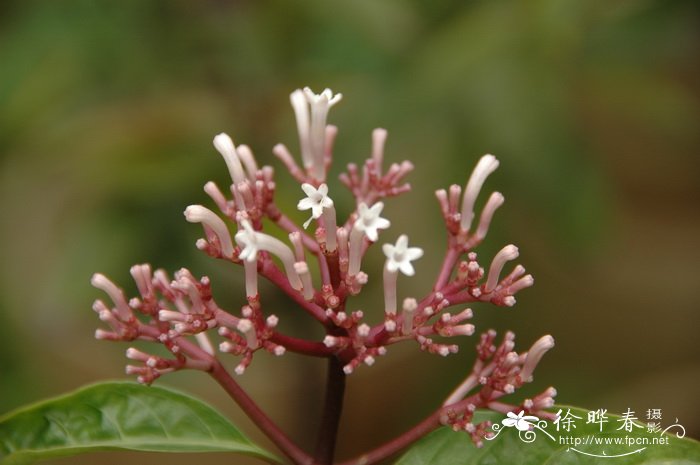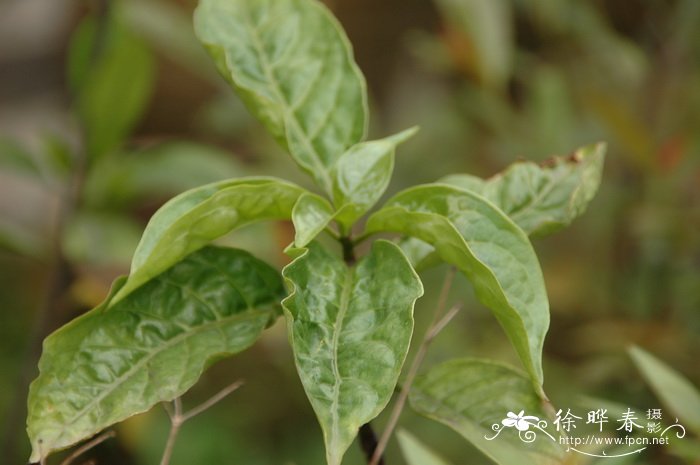弯管花Chassalia curviflora
中文名(Chinese Name):弯管花
学名(Scientific Name):Chassalia curviflora (Wall.) Thwaites
英文名(English Common Name):
别名(Chinese Common Name):
异名(Synonym):Chasalia curviflora Thwaites Chasallia curviflora Thwaites Uragoga curviflora (Wall.) Kuntze Psychotria curviflora Wall.
科属(Family & Genus):茜草科(Rubiaceae)弯管花属
形态特征(Description):直立小灌木,高1-2米,通常全株被毛。叶膜质,长圆状椭圆形或倒披针形,长10-20厘米,宽2.5-7厘米,顶端渐尖或长渐尖,基部楔形,边全缘,干时黄绿色;侧脉每边8-10条,纤细,上面清楚可见;叶柄长1-4厘米,无毛;托叶宿存,阔卵形或三角形,长4-4.5毫米,短尖或钝,全缘或浅2裂,基部短合生。聚伞花序多花,顶生,长3-7厘米,总轴和分枝稍压扁,带紫红色;苞片小,披针形;花近无梗,3型:花药伸出而柱头内藏,柱头伸出而花药内藏,或柱头和花药均伸出;萼倒卵形,长1-1.5毫米,檐部5浅裂,裂片长不及0.5毫米,短尖;花冠管弯曲,长10-15毫米,内外均有毛,裂片4-5,卵状三角形,长约2毫米,顶部肿胀,具浅沟。核果扁球形,长6-7毫米,平滑或分核间有浅槽。花期春夏间。
分布(Distribution):产广东、海南、广西和云南、西藏,常见于低海拔林中湿地上。分布于中南半岛和印度、不丹、斯里兰卡、孟加拉国、马来西亚、加里曼丹等地。
用途(Use):
引自中国植物志英文版:FOC Vol. 19 Page 59, 87
Chassalia curviflora (Wallich) Thwaites, Enum. Pl. Zeyl. 150. 1859.
弯管花 wan guan hua| Rubiaceae | Chassalia
Subshrubs, erect, 1-2 m tall; branches weakly flattened to subterete, glabrous or rarely sparsely puberulent. Leaves opposite; petiole 1-4 cm, glabrous; blade drying membranous to thinly papery and often yellowish green, oblong-elliptic, elliptic, oblanceolate, or narrowly lanceolate, 6-27 × 1.5-7.5 cm, glabrous, base cuneate to attenuate, apex acuminate to long acuminate; secondary veins 8-17 pairs, without domatia; stipules persistent, united shortly around stem, with interpetiolar portion broadly ovate or broadly triangular, 1.5-4.5 mm, acute or obtuse, entire or usually shortly bifid, with 1 or 2 bristles 0.3-1 mm, often gland-tipped. Inflorescence cymose, pyramidal to rounded, several to many flowered, puberulent; peduncle 1-5 cm; branched portion 3-7 cm; axes weakly flattened; bracts lanceolate to triangular or usually multifid, 0.5-3 mm. Flowers subsessile, trimorphic: with anthers exserted and stigmas included, with anthers included and stigmas exserted, or with anthers and stigmas both exserted. Calyx with hypanthium portion ellipsoid to obovoid, 1-1.5 mm, glabrous; limb 5-lobed, 0.5-1 mm; lobes 0.3-0.5 mm, acute. Corolla white with pink, red, or orange on lobes, outside glabrous to sparsely puberulent and longitudinally ridged to winged along tube then midribs of lobes; tube shallowly to markedly curved, straight or bent at base, 10-15 mm, pubescent inside; lobes (4 or)5, ovate-triangular, 2-2.5 mm, at apex thickened. Infructescence axes becoming swollen and red. Fruit purple, oblate to globose or weakly didymous, 5-7 × 6-9 mm. Fl. Apr-Jun, fr. Apr-Jan.
Wet places, forest understories, at low elevations; 100-2000 m. Guangdong, Guangxi, Hainan, Xizang, Yunnan [Bangladesh, Bhutan, Borneo, Cambodia, E and NE India (including Andaman Islands), Indonesia, Malaysia, Philippines, Singapore, Sri Lanka, Thailand, Vietnam].
At anthesis the corolla tube curves upward so that the base of the tube is suberect, the middle portion of the tube arcs toward the horizontal, and the mouth of the corolla opens outward to the side (Puff et al., Rubiaceae of Thailand, 101. 2005). Other authors have found this species distylous with the flowers 5-merous or infrequently 4-merous on aberrant individual flowers, as in many Rubiaceae; H. S. Lo (in FRPS 71(2): 61. 1999) described it as tristylous with often 4 corolla lobes.


(责任编辑:徐晔春)
学名(Scientific Name):Chassalia curviflora (Wall.) Thwaites
英文名(English Common Name):
别名(Chinese Common Name):
异名(Synonym):Chasalia curviflora Thwaites Chasallia curviflora Thwaites Uragoga curviflora (Wall.) Kuntze Psychotria curviflora Wall.
科属(Family & Genus):茜草科(Rubiaceae)弯管花属
形态特征(Description):直立小灌木,高1-2米,通常全株被毛。叶膜质,长圆状椭圆形或倒披针形,长10-20厘米,宽2.5-7厘米,顶端渐尖或长渐尖,基部楔形,边全缘,干时黄绿色;侧脉每边8-10条,纤细,上面清楚可见;叶柄长1-4厘米,无毛;托叶宿存,阔卵形或三角形,长4-4.5毫米,短尖或钝,全缘或浅2裂,基部短合生。聚伞花序多花,顶生,长3-7厘米,总轴和分枝稍压扁,带紫红色;苞片小,披针形;花近无梗,3型:花药伸出而柱头内藏,柱头伸出而花药内藏,或柱头和花药均伸出;萼倒卵形,长1-1.5毫米,檐部5浅裂,裂片长不及0.5毫米,短尖;花冠管弯曲,长10-15毫米,内外均有毛,裂片4-5,卵状三角形,长约2毫米,顶部肿胀,具浅沟。核果扁球形,长6-7毫米,平滑或分核间有浅槽。花期春夏间。
分布(Distribution):产广东、海南、广西和云南、西藏,常见于低海拔林中湿地上。分布于中南半岛和印度、不丹、斯里兰卡、孟加拉国、马来西亚、加里曼丹等地。
用途(Use):
引自中国植物志英文版:FOC Vol. 19 Page 59, 87
Chassalia curviflora (Wallich) Thwaites, Enum. Pl. Zeyl. 150. 1859.
弯管花 wan guan hua| Rubiaceae | Chassalia
Subshrubs, erect, 1-2 m tall; branches weakly flattened to subterete, glabrous or rarely sparsely puberulent. Leaves opposite; petiole 1-4 cm, glabrous; blade drying membranous to thinly papery and often yellowish green, oblong-elliptic, elliptic, oblanceolate, or narrowly lanceolate, 6-27 × 1.5-7.5 cm, glabrous, base cuneate to attenuate, apex acuminate to long acuminate; secondary veins 8-17 pairs, without domatia; stipules persistent, united shortly around stem, with interpetiolar portion broadly ovate or broadly triangular, 1.5-4.5 mm, acute or obtuse, entire or usually shortly bifid, with 1 or 2 bristles 0.3-1 mm, often gland-tipped. Inflorescence cymose, pyramidal to rounded, several to many flowered, puberulent; peduncle 1-5 cm; branched portion 3-7 cm; axes weakly flattened; bracts lanceolate to triangular or usually multifid, 0.5-3 mm. Flowers subsessile, trimorphic: with anthers exserted and stigmas included, with anthers included and stigmas exserted, or with anthers and stigmas both exserted. Calyx with hypanthium portion ellipsoid to obovoid, 1-1.5 mm, glabrous; limb 5-lobed, 0.5-1 mm; lobes 0.3-0.5 mm, acute. Corolla white with pink, red, or orange on lobes, outside glabrous to sparsely puberulent and longitudinally ridged to winged along tube then midribs of lobes; tube shallowly to markedly curved, straight or bent at base, 10-15 mm, pubescent inside; lobes (4 or)5, ovate-triangular, 2-2.5 mm, at apex thickened. Infructescence axes becoming swollen and red. Fruit purple, oblate to globose or weakly didymous, 5-7 × 6-9 mm. Fl. Apr-Jun, fr. Apr-Jan.
Wet places, forest understories, at low elevations; 100-2000 m. Guangdong, Guangxi, Hainan, Xizang, Yunnan [Bangladesh, Bhutan, Borneo, Cambodia, E and NE India (including Andaman Islands), Indonesia, Malaysia, Philippines, Singapore, Sri Lanka, Thailand, Vietnam].
At anthesis the corolla tube curves upward so that the base of the tube is suberect, the middle portion of the tube arcs toward the horizontal, and the mouth of the corolla opens outward to the side (Puff et al., Rubiaceae of Thailand, 101. 2005). Other authors have found this species distylous with the flowers 5-merous or infrequently 4-merous on aberrant individual flowers, as in many Rubiaceae; H. S. Lo (in FRPS 71(2): 61. 1999) described it as tristylous with often 4 corolla lobes.
(责任编辑:徐晔春)
踩一下[0]

顶一下[0]